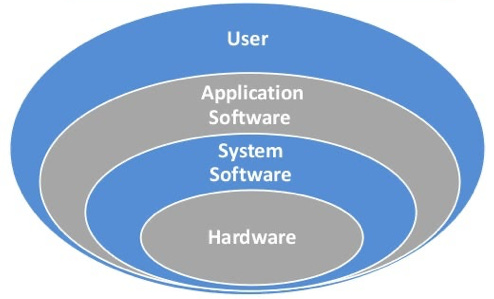May, 2022
Sometimes there’s a technology that captures our minds so much that it becomes a metaphor for practically everything. The universe — and the mind — seemed like an infinitely complex clockwork back in the days when the mechanisms inside clocks were new and fascinating. The “clockwork universe” showed up around the 1400s, and might have first appeared the book On the Sphere of the World by John of Sacroboso. He described the universe as the “machine Mundi.” The “machine of the world.”

Then came steam engines. They were an expression of the power that could be wielded if you had the understanding, and the craft, to shape the world.
And now there’s software. Do you find yourself imagining your own mind as a kind of computer? So does everybody else, it seems. The important part of computers, the part that acts, is software.

Software is a set of instructions. Magic words. You can tell the computer to perform functions it’s capable of in a particular order. But it goes beyond just that. The more I think about software, the deeper the subject seems to get. That’s what took so long to put this issue together. I was haunted by demons.
The Demon-Haunted World
I find software deeply captivating. But what’s fascinating about software is not so clear. Is it the idea of instructions causing actions? I think it might be a recognition that these are real magic words. The core notion of magic (at least the popular depiction of magic that I know about) is that words can have power. If you know the “true name” of a thing, or a person, you can control it, or them. Speak the right words, the secret words, and your wants and needs can be fulfilled without going through the tedious rigamarole of, you know, working indirectly to get the money to buy the stuff or hire the people that you can use to fulfill the needs that you hopefully remember at that point. It might not be without cost — even Harry Potter has to study his spells — but the payoff is far more immediate than you get from, say, a degree in chemistry.

It’s the numinous, glowing power beneath magic words that’s behind the magnetism of software. In the early days of computers, your magic words mostly controlled other glowing words on screens. More recently the magic words control images that grow more and more toward life — toward reality — every year. And even more recently, you can put on a set of magic glasses and see your magic words control things that exist in three dimensions. You can’t quite touch them though. Not yet. The magic is trying to emerge into our reality, and it’s looming closer and closer.
I think this underlying idea was expressed in ancient times too. Spirits. Demons. Magic. You can even find some commentary here and there online — I don’t know whether it’s intended to be serious — about the internet being created by, or maybe consisting of, demons. But de-invest those words; remove their emotional baggage. The word “demon” is an ancient attempt to describe something that’s active in some world — not necessarily our “real world” — and that can exert some agency. A little bit like one of us; an active participant in a universe.
Our convenient modern metaphors give us a bit more lexical range: software, apps, computers, networks, internet, computer learning, artificial intelligence. We may have only a rudimentary grasp of the real details of all these things, but maybe that’s not important. Maybe it’s vocabulary itself that makes us feel more in control, superior and in possession of a certain degree of mastery. Those uninformed ancients lacked our metaphorical scope, right? Or did they?

Have you ever explored the intricacies of the language and lexical range of the alchemists? They had a surprising metaphorical scope. And the myriad details of the angelic and saintly realm mapped over many centuries by the Catholic church are similar; they describe a complex, multilayered reality not all that removed from how a computer operating system might be described. If we’re just thinking in terms of the language itself, things like the alchemists’ and religious scholars’ lexicons may be the equal of our “technical” argot.
You might protest that the things we’re talking about — computers and software systems — deliver actual results that the old hocus-pocus stuff never could. But are you sure there’s that much difference? Other than the visual effects in modern gaming and animation, the end result of a lot of very advanced software is simply a list of things we’re told about. Complex software tells us the probabilities of a storm coming. Sometimes the storm arrives; sometimes not. But augury has been practiced before. Maybe we’re a bit better at it now, but then again… was anybody keeping detailed records of such things back then?
Silicon, Unite
We usually think of software as instructions that are executed in a digital computer — a silicon substrate, so to speak. But I think that’s only one instance of software. Ada Lovelace is celebrated as the world’s first computer programmer, but the programs she wrote were made to be executed on Charles Babbage’s Analytical Engine. That was a purely mechanical computer; silicon-based semiconductors weren’t invented until a century later. Alan Turing proposed a “universal computer” that was made of paper. Danny Hillis, founder of Thinking Machines corporation, built a working computer out of Tinkertoys (you can see it at the Computer History Museum in California). So software can be executed on a variety of substrates; it doesn’t require a computer with silicon semiconductors.
Chess is a game played by humans, and if it’s a computer game, it’s played on a silicon substrate. Have you ever seen a human chess game? It’s where instead of a tabletop board, you lay out an 8×8 grid big enough for people to stand in, representing the chess pieces. Now, chess is a game that’s governed by a set of rules. Instructions of a sort. It’s a metaphorical battle between two armies, directed by the opposing human players. But chess computers are common now, and at the highest level they’re as good as the best humans. So imagine a chess game where the “players” are two computer programs, and the pieces are humans. Now it’s a game played by silicon on a human substrate.

So software — sets of instructions — can be executed in people. This is, in fact, something you see in practice every day. Drive around a city and you’ll find traffic signals. When they glow red, people stop their cars, and start up again when the signal turns green. That’s people following instructions — and just like the reverse chess game, traffic signals are mostly controlled by computers now, so the software is running on silicon and executed in people.
In a general sense, I think there’s some discomfort with the idea of computers providing instructions to people, and for that matter, what’s all this about everybody following instructions? Aren’t we supposed to be “free” and all that?
Something about the whole scenario of software programs running on a human substrate feels just a bit off. But it happens all the time, and it’s been happening for millennia. Militaries, laws, families, clans, tribes, societies, religions, corporations — they’re all software that runs on a substrate of people.
If you study software, you’ll notice that there are different levels, or layers, that a program can run on within a silicon computer. A program can run on the most obvious layer — the user interface — or on a background layer that you, using the computer, aren’t directly aware of at all. I think the same thing happens when software runs on people.

Think of a military. The primary level for its software is the “top layer,” physical behavior. You can see it, and you can command it. But sometimes the commands about physical behavior — the “instruction set” — migrates to a deeper, background layer: the mental and emotional “operating system” of the people involved. In a military you might be ordered to attack an enemy. But some people in that situation do more. There’s even a phrase for it: “above and beyond.” You’re exceeding the specific instructions you were given, and running the lower-level ideas behind those instructions to produce your own behaviors. Maybe you rescue your squad or single-handedly attack an enemy position. This is a great victory for the software installed by the military. If you do something extraordinary like that, you’re treated in an extraordinary way. You might win a medal. Or in the opposite extreme, of course, there are military firing squads.

Societies are software too; the instruction set is the laws and customs that citizens follow and share. Corporations work that way too. When you’re hired, you’re given the explicit instruction set, and in many cases you’ll get information about the implicit instructions too — the “corporate culture.”
The software running on humans has layers just like the silicon version. This is probably inevitable; after all, the same species that came up with societies, armies, and companies is also programming computers, and we only have so much imagination. In the case of corporations, the corporate culture and rules of conduct are one layer, and in a lot of the world, a deeper layer is the economic and legal environment the corporation “lives in.” I think “lives” is the right word here, because a corporation is in many senses a living entity. It can survive practically anything, and although in the US there was once such a thing as a “firing squad” for misbehaving corporations, that doesn’t seem to have existed for a long time.
Google once had a famous motto: “don’t be evil.” That didn’t last. I would argue that it couldn’t last, because although it was part of the top-layer rule set, it directly contradicted a lower-level instruction set. After all, in corporate capitalism, evil is pretty much a foundational principle. “It’s business” is much closer to acceptable, and there’s an implicit message in that adage: go ahead and be evil; it’s expected. There’s a line in The Godfather when a character is about to be executed. He knows it, and knows his executioners, and they all agree there’s no hard feelings; “it’s just business.”
I haven’t even begun to touch on the kinds of software that comprise religions, families, and the like. I’ve discovered that “software” is such a powerful notion that once you start thinking of it as a basic metaphor, you can describe practically any human activity that way. And it doesn’t feel very complimentary to the humans involved. After all “just following orders” isn’t supposed to excuse behavior that’s actually evil. But in many realms, I think maybe it does. It’s just that the “orders” aren’t always stated overtly. There are so many ways we act in ways that are completely predictable, even if nobody specifically told us to. We’ve just been very well programmed.
—
This post’s title, How to become wise? is the question asked by Theages, the son of Demodocus. Demodocus introduces Theages to Socrates in the Dialog of Theages. It’s an ancient dialog attributed to Socrates. Modern opinion is that it is probably from a different, but still ancient, source. I used it here because that dialog is one where Socrates mentions the notion of his personal daemon. This is where the version of “daemon” used in computing comes from — it’s not the much more recent version of “demon” that’s some sort of imp or lesser devil. To Socrates, his daemon is an inner voice that warns him against mistakes, but never explains what to do.

In other writings, Socrates (as reported by Plato) reports that the priestess Diotima taught him that a daemon is a sort of go-between sometimes connecting the divine and mortal realms.
The section title The Demon-Haunted World, is taken from the book by Carl Sagan and Ann Durban. They were talking not about software, but about the scientific method and how (and whether) non-scientists understand it.
It’s not exactly about software, but have a look at The Universe is Not What You Think It Is by Justin E. H. Smith. Here is a review that inspired some of my musings into demons and daemons.
